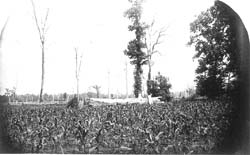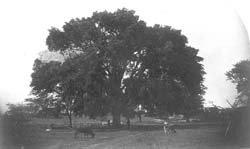
 |
| Ridgway
photograph collection,
click on image to enlarge Illinois State Museum collection |
European settlers wanted to farm in forest areas. They thought the prairie soils were infertile because trees did not grow there. The sod was difficult to break, and until the development of the self-scouring plow (links to Midewin NTP Web exhibit - use back button to return here) in 1837, plowing was a slow, labor-intensive process.
Drainage was poor on the flat prairies and with settlement, farmers began to drain them by using drainage tiles. Among the early settler, forest were considered to be the first and best choice for agriculture until the middle 1800s.
Grazing by cattle and hogs resulted in significant changes in the understories of many Illinois forests. Early land surveyors often made note of 'hazel' (Corylus americana) in the shrubby understory of oak groves and savannas. Hazel trees were common in groves prior to European settlement. They disappeared from the savannas along with the rest of the shrubby understory because domestic livestock grazed there and ate the young plants and seed nuts.
 |
| Ridgway
photograph collection,
Illinois State Museum collection |
The prairies became more attractive as agricultural lands when settlers recognized their fertile soils and the self-scouring plow was developed in 1837. Over 300,000 people settled the prairies during this time period. Settlers in Illinois still used wood from trees on their property to build their homes and make their furniture, tools, and utensils like the ones in the Illinois State Museum collection.
The
demand for timber continued
Deforestation continued steadily at a rate of about 1% per year between approximately 1830 and 1880. In the 1830s and 1840s, local timber supplies on the prairies (savannas, groves, streamside forests) were rapidly being used up for building materials and fuel because wood had to be obtained from local sources. It was only later that wood products could be brought to Illinois by railroad. That opened up a large timber industry.
|
|
Copyright © 2000 Illinois State Museum